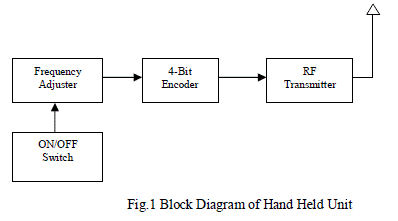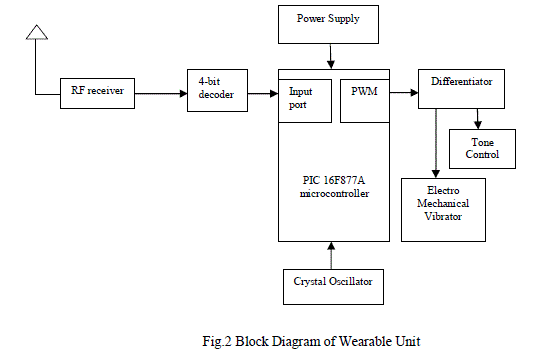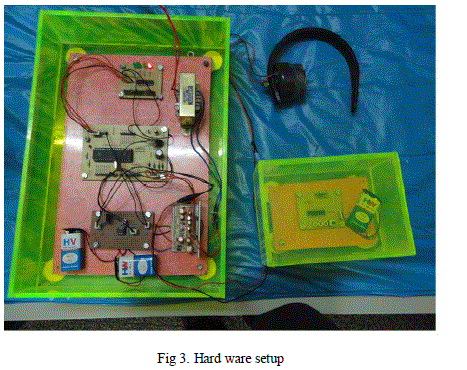ISSN ONLINE(2278-8875) PRINT (2320-3765)
ISSN ONLINE(2278-8875) PRINT (2320-3765)
| C.Prajitha and D.Pradeepa PG Scholar, Dept. of EEE, Dr. Mahalingam college of engineering and Technology,Pollachi, Tamilnadu, India |
| Related article at Pubmed, Scholar Google |
Visit for more related articles at International Journal of Advanced Research in Electrical, Electronics and Instrumentation Engineering
In this brief, an electronic inventory was developed that serves laryngectomee (people who have lost their speech functions by surgical removal of the larynx). Most of those people have to learn an oesophageal speech method that uses an oesophageal organ to produce a sound source instead of vocal cords. The Electro Mechanical Vibrator (EMV) consists of two parts: Wearable unit and Hand held unit. The hand held unit transmit the signal to the wearable unit which makes the EMV to vibrate, due to this vibration the people can able to deliver speech. The overall objective of this wearable electro mechanical vibrator is to develop the best possible technical results as a wearable module.
Keywords |
| Laryngectomee, Wearable unit, Hand held unit, Electro mechanical vibrator. |
INTRODUCTION |
| Cancer of the larynx occurs most often in people over the age of 55 years. People who stop smoking can greatly reduce their risk of cancer of the larynx. Treatment of cancer of the larynx depends on the location and size of the tumor as well as the age and health of the patient. Cancer of the larynx is usually treated with radiation therapy or surgery. Chemotherapy can also be used for cancers that have spread. Laryngeal cancer cells can spread by breaking away from the tumour in the larynx. After spreading, laryngeal cancer cells may attach to other tissues and grow to form new tumours. The total neck breather is a laryngectomee; that is, an individual whose larynx (voice box) has been removed because of cancer. A laryngectomee breathes only through a permanent opening in the neck, called a stoma. The laryngectomee may have trouble speaking. Some laryngectomees speak by shunting air from the lungs through a surgically created tunnel between the trachea and esophagus. |
| Various methods for vocal rehabilitation have been applied for people, called laryngectomee, who have lost their speech functions by surgical removal of the larynx. Most of those people have to learn an oesophageal speech method that uses an oesophageal organ to produce a sound source instead of vocal cords. However, it is not easy for them, especially elderly people, to completely master oesophageal speech because it requires a great amount of physical training.The overall objective of this wearable electro mechanical vibrator is to develop the best possible technical results as a wearable module. A wearable electro-mechanical vibrator is one of speech-substitute devices for patients who have lost laryngeal function. Laryngeal function is lost due to the formation of polyps (cancer). In this case, the vibrations will not be produced in the soft tissues. Thus using this device we vibrate the soft tissues in neck, thus producing a voice which resembles the human voice. |
RELATED WORK |
| Bellandese et al (2001) proposedacoustic data for female esophageal speakers is sparse, particularly with regard to characteristics of female tracheoesophageal speakers.This study quantified and compared six acoustic characteristics of excellent female tracheoesophageal (TE), standard esophageal (SE), and laryngeal (LA) speakers.Results indicated there were no significant differences between TE and SE speakers with regard to signal-to-noise ratio, total duration of passage read, number of pauses, or syllables per minute. Significant differences were found between LA speakers and both alaryngeal groups for all variables. |
| Arantza del Pozo, Steve Young (2006) proposed an investigation into the repair of continuous tracheoesophageal (TE) speech. This also has presented a continuous TE speech repair sys-tem based on the correction of deviant characteristics in the source and vocal tract. The enhanced system has been shown to reduce breathiness and harshness of the original TE speech and to be preferred over the baseline. |
| Corina J. van As-Brooks et al (2006) proposed the development and testing of an acoustic signal typing system based on visual inspection of a narrow-band spectrogram that can be used by researchers for classification of voice quality in tracheoesophageal speech. Five of these measures are regularly used by researchers for acoustic analysis of voice quality: fundamental frequency, standard deviation of fundamental frequency, jitter, HNR, and %Voiced. The results of this study imply that this acoustic signal typing system might be a valuable clinical tool for documentation, investigation, and follow-upof voice quality in tracheoesophageal speech. |
| Thomas Drugman et al (2013) proposed after total laryngectomy, the placement of a tracheoesophageal(TE) puncture offers the possibility to gain a new voice. However, the produced TE speech is known to have a lower quality and intelligibility. The goal of this paper is to identify and quantify the acoustic artefacts in TE speech. Four categories of acoustic artefacts were identified: a lower periodicity and regularity of the phonation, and the presence of high-frequency and gargling noises. |
| Electro mechanical vibrator is attached to the neck of the laryngectomee in order to put vibratory sounds into the oral cavity. It looks like a flash light. The battery life is not long lasting. However, this prosthesis makes it difficult to produce phonetic information such as intonation and accent. Therefore, the produced voice becomes monotone, unlike the human voice. In addition to that, conventional electro-larynx causes a lot of inconvenience in daily use because the conventional ones force them to hold and control the device while using it. |
| Disadvantages of existing method. |
| 1. Hand held device |
| 2. Uneasy to operate |
| 3. Absence of pitch control function |
| 4. Discomfort |
PROPOSED METHOD |
| Wearable electro mechanical vibrator is designed by using latest technology. Our paper contains a wearable unit and a hand held unit. Desired frequency is selected by the user in the hand held unit using 3 push buttons and a ON/OFF switch. Thus corresponding vibration is delivered by the wearable unit which is attached to the patient’s neck using a thermoplastic brace, on which the vibrator is placed. Communication between wearable and hand held unit is performed using RF (a wireless system). In order to improve it, we have added frequency control and tone control. A voice produced by wearable electro mechanical vibrator is similar to the human voice. |
| Advantages of proposed method |
| 1. To develop a hand free device. |
| 2. Frequency control and tone control. |
| 3. Rechargeable batteries. |
| 4. Easy to use. |
DESCRIPTION |
| A. Hand Held Unit |
| Hand held unit consists of ON/OFF switch, frequency adjuster, 4 bit encoder and an RF transmitter. |
 |
| Hand held unit consists of 3 push buttons and one ON/OFF switch. Push buttons is used to select desired frequency. Under ON/OFF condition, 3 frequency levels are delivered. Various frequency levels are included for the user’s comfort, because the laryngectomee tissues become hard, after the removal of cancer by radiation therapy. When a single button has been pressed a data is transmitted which is encoded and given to a 434 MHZ RF transmitter. The vibrations will be delivered until switch is pressed. Different frequency ranges can be obtained by changing the time period of the pulse. |
| 1) Encoder |
| The HT 12E Encoder ICs are series of CMOS LSIs for Remote Control system applications. They are capable of Encoding 12 bit of information which consists of N address bits and 12-N data bits. Each address/data input is externally trinary programmable if bonded out. |
| 2) Transmitter |
| The TWS-434A transmitter accepts digital inputs, can operate from 1.5 to 12 Volts-DC, and makes building a miniature hand-held RF transmitter very easy. The TWS-434A is approximately the size of a standard postage stamp. The transmitter output is up to 8mW at 433.92MHz with a range of approximately 400 foot (open area) outdoors. Indoors, the range is approximately 200 feet, and will go through most walls. Here, the signal is collected at the pin 2 of transmitter and it is modulated to 434MHz. These modulated frequencies are transmitted to the receiving unit through the antenna. |
| B. Wearable Unit |
| Wearable unit contains RF receiver, 4 bit decoder, microcontroller, differentiator and a tone control. The transmitted signal is received by the receiver. The information is decoded by 4 bit decoder and then given to microcontroller. According to the selected frequency PWM will generate a square pulse with constant duty cycle and desired frequency which is selected in the hand held unit and then given to differentiator circuit to obtain a differentiated pulse. The tone is adjusted as per the need of the user.The frequency obtained will be in the range of 30 to 150 HZ which is the normal frequency of the human voice for male. Normal frequency for the female is 200 to 350 HZ. These settings are adjusted with the help of push buttonsin the hand held unit. The differentiated pulse is then given to the electromechanical vibrator. |
| 1) Receiver |
| The receiver (RWS-434)receives the signal in pin 8 and it is demodulated. The output is given to decoder through pin 2. The RWS-434A receiver module also operates at 433.92MHz, and has a sensitivity of 3uV. The receiver operates from 4.5 to 5.5 volts-DC, and has both linear and digital outputs.Thereceiver section using the HT-12D decoder IC for a 4-bit RF remote control system. The module uses ASK as the form of modulation and has both digital and analogue outputs. ASK super heterodyne receiver module and high sensitivity design. |
 |
| 2) Decoder |
| The Decoder receive the serial address and data from its corresponding decoder, transmitted by a carrier using an RF transmission medium and gives output to the output pins after processing the data. |
| 3) Microcontroller |
| Microcontroller is a general purpose device, which integrates a number of components of a microprocessor system on to a single chip. A microcontroller is a small computer on a single integrated circuit consisting of a processor core, memory, and programmable input/output peripherals. Microcontrollers are designed for embedded applications, in contrast to the microprocessors used in personal computers and other general purpose applications. |
| It reducing the size and cost compared to a design that uses a separate microprocessor, memory, and input/output devices. It make economical to digitally control even more devices and processes. Mixed signal microcontrollers are common, integrating analog components needed to control. Some microcontrollers may use four-bit words and operate at clock rate frequencies as low as 4 kHz, for low power consumption (milliwatts or microwatts). They will generally have the ability to retain functionality while waiting for an event such as a button press or other interrupt; power consumption while sleeping (CPU clock and most peripherals off) may be just nanowatts, making many of them well suited for long lasting battery applications. Other microcontrollers may serve performance-critical roles, where they may need to act more like a digital signal processor (DSP), with higher clock speeds and power consumption. |
| 4) Electromechanical vibrator |
| The vibrator used in this project is a normal 2” 5 Watts round speaker. A speaker is an electro acoustic transducer that produces sound in response to an electrical audio signal input. |
| Input signal to the coil generates a vertical force in accordance with Fleming’s left-hand rule. The direction of the force depends on the size and direction of the input signal. The diaphragm also moves vertically in line with the generated force. Vertical movement of the diaphragm attached to the coil vibrates the surrounding air, producing sound.The diaphragm and magnetic circuit will oscillate by continually attracting and repelling one another. At slow oscillation speeds (i.e. low frequencies), the heavy magnetic circuit is more efficient, and its movement generates vibration. At fast oscillation speeds (i.e. high frequencies), the magnetic circuit is unable to oscillate at the required speed, while the lighter diaphragm becomes more efficient, and the result is sound without vibration. |
| 5) Crystal oscillator |
| Crystal oscillator is an electronic oscillator circuit that uses the mechanical resonance of a vibrating crystal of piezoelectric material to create an electrical signal with a very precise frequency. This frequency is commonly used to keep track of time (as in quartz wristwatches), to provide a stable clock signal for digitalintegrated circuits, and to stabilize frequencies for radio transmitters and receivers. The most common type of piezoelectric resonator used is the quartz crystal, so oscillator circuits designed around them became known as "crystal oscillators." |
| When a crystal of quartz is properly cut and mounted, it can be made to distort in an electric field by applying a voltage to an electrode near or on the crystal. This property is known as piezoelectricity. When the field is removed, the quartz will generate an electric field as it returns to its previous shape, and this can generate a voltage. The result is that a quartz crystal behaves like a circuit composed of an inductor, capacitor and resistor, with a precise resonant frequency. |
| 6)Receiver |
| The receiver (RWS-434) receives the signal in pin 8 and it is demodulated. The output is given to decoder through pin 2. The RWS-434A receiver module also operates at 433.92MHz, and has a sensitivity of 3uV. The receiver operates from 4.5 to 5.5 volts-DC, and has both linear and digital outputs. The receiver section using the HT-12D decoder IC for a 4-bit RF remote control system. The module uses ASK as the form of modulation and has both digital and analogue outputs. ASK super heterodyne receiver module and high sensitivity design. |
RESULT AND DISCUSSION |
| 1) Fabrication of the units |
| Our project consists of two units namely, hand held unit and wearable unit. Hand held unit consists of a frequency selector, encoder and a transmitting part. Hand held unit is completely battery operated. Wearable unit contains a receiving section, decoder, and then given to microcontroller. According to the desired frequency selector pulse width modulation pin delivers square pulse from the microcontroller. The received signal is differentiated and then delivered to vibrator. Wearable unit is operated with 12V in order to drive the vibrator circuit. 5V regulated supply is provided for the transmitting and receiving section. Vibrator is mounted on a plastic brace which is highly flexible and can be adjusted for the patient’s size of the neck. |
| 2) Experimental Approach |
| The examination is performed on a patient who had his larynx removed due to laryngeal cancer. Wearable unit is strapped to the neck region. Hand held unit is operated by the patient according to his own requirement. The frequencies are selected using the push buttons in the hand held unit and the signals are transmitted. The transmitted signals are received by the wearable unit strapped to the neck. A robotic voice is obtained from the patient when the frequency produced resonates with the vibrations in the neck. A voice is produced when the differentiated pulse is allowed to travel through neck region. Frequencies are selected according to the condition of the patient. High frequencies are used for patients whose muscles have become harder due to treatment with radiation therapy. Loudness is increased according to the environmental needs. After proper placement of the vibrator, patients are trained to speak few words which are simpler. Systematic training is given until a clear voice is obtained. The clear voice is obtained after training for a definite period of time till the patient is confident of its use. |
| 3) Case Study |
| In order to verify the performance of our prototype model, we tested it with three different patients. Two patients taken for the case study had undergone radiation therapy after removal of their laryngeal cancer and the third patient had undergone surgery and subsequent radiation therapy for the total removal of cancer cells. |
| 4)Description of Patients The first laryngectomy patient considered was Mr.S. Varatharajan, age 55 years, total body weight 58 Kg and height160 cm. He had undergone radiation therapy to remove his cancerous cells. With the help of our prototype 40% of his original voice was regained. |
| The second laryngectomy patient considered was Mr. K. Palanisamy, age 52, total body weight 60 Kg and height 158 cm. He had undergone a surgery along with radiation therapy after removal of his laryngeal cancer. Obtained results were appreciated because of slower healing, since he is a diabetic patient. |
| The third laryngectomy patient considered was Mr. N. Nallamuthu, age 50 years, his total body weight 45 Kg and height is 150 cm. He has undergone radiation treatment to remove his cancerous cells. With the help of our prototype about 60% of the expected result is obtained. Better results are expected continuous training. |
| 5) Discussion |
| In all the three patients it was found that the result obtained is more or less similar to a robotic voice. More accuracy is obtained from the third patient after the repeated training. The result obtained from the second patient was comparatively less when compared with the other patients. Average result is obtained from the first patient. Good results are obtained from the third patient and better results are expected in future after repeated use. |
 |
CONCLUSION |
| Electro-mechanical vibrator for voice synthesis is a helpful tool for the laryngectomee patients. In the existing method people do not feel comfortable to handle the device while performing some task. In this project we have overcome the inconvenience by making the tool as a wearable. Various levels of frequencies are set for the patients need. |
References |
|